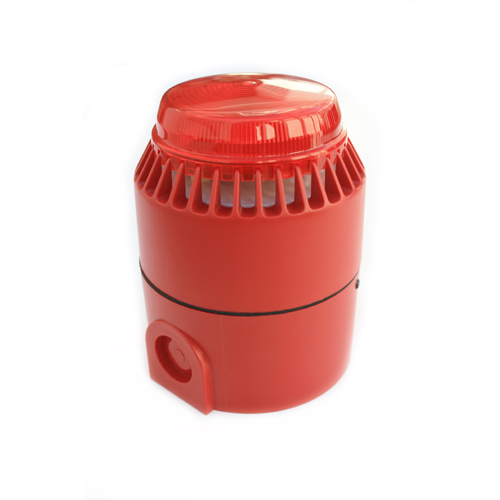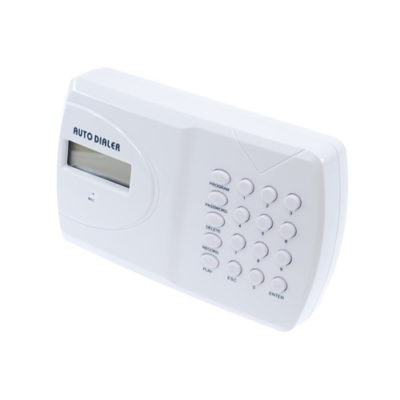Siren Beacon
Part No: RF524 (3618366)The RF524 Siren Beacon is an audible and flashing alarm notification of out of range temperatures.
- Connects to RF500 System Gateways
- 101dB(A) Sound Output
- Power Supply Supplied
- Warranty: 1 Year
Siren Beacon
The RF524 Siren Beacon is an audible and flashing alarm notification of out of range temperatures. For use whenever a local alert is required.
The RF524 Siren Beacon connects to your RF500A or RF500AP System Gateway.
Technical Specifications
| Name | Value |
|---|---|
| Voltage | 18 - 28V DC |
| Current | 68mA (Typical Tone 3) |
| Sound Output | 101dB(A) (Typical Tone 3) |
| Volume Control | 10dB |
| Flash Power | 0.7j |
| Light Source | Xenon |
| Flash Rate | 1Hz |
| Operating Temperature Range | -10ºC to + 55ºC / 14ºF to + 131ºF |
| Compliance | IP65 (product exceeds minimum requirements of IP21C as required by EN54-3) |
| Materials | ABS, Polycarbonate Lens |
| Weight | 0.33Kg |
| Packaging Contents | 1 x Siren/Beacon, 1 x 24V PSU with 2m lead fitted with Jack Plug |
| Dimensions | 121mm x 93mm |
| Warranty | 1 Year |
*You will need to Sign In to view additional content
Documentation
| Code | Description | Issue No | Last Modified | |
|---|---|---|---|---|
| 20445 | RF500 Wireless Monitoring Brochure | 02 | 3rd June 2016 |
Articles / FAQs
| Name | Date | ||||||||||
|---|---|---|---|---|---|---|---|---|---|---|---|
Door Sensor Alarms ExplainedDoor Sensor Alarms ExplainedThe following information explain the types of alarms generated by the Door Sensors connected to your RF500 Monitoring System. Continuous Door AlarmsA Continuous Door Alarm is defined as an alarm that is triggered whenever a door is left continuously open for a period of more than X minutes. Please refer to the ‘Door Alarms’ chapter under ‘Transmitter Alarms’ in the RF500-Webview Help Guide for a detailed explanation of Continuous Door Alarms. Average Door AlarmsAn average Door Alarm Door is defined as an alarm that is triggered whenever a door is left open for more than X minutes cumulatively, in a given period of up to 60 minutes. This alarm captures many individual shorter door open times, that may fail to trigger a continuous door alarm, but are nonetheless still important. Please refer to the ‘Door Alarms’ chapter under ‘Transmitter Alarms’ in the RF500-Webview Help Guide for a detailed explanation of Average Door Alarms. Reading Door Alarm DataBoth continuous and average door alarms are enabled or disabled together, therefore if the average door alarm is not required, setting the average limit equal to the average period causes the average alarm never to occur because the limit can not be exceeded. Whenever a continuous door alarm is triggered an Event only is generated, tabular data will not be coloured to indicate the alarm.
A representation of tabular data shown above shows a typical reading. The readings reported for the door channel are given as two values:
The percentage gives a measure of how much time a door actually spends opened which could represent a problem in a real world application. Consider the following scenario: A door to a laboratory is monitored using RF500 and the continuous alarm is set to 20 minutes to capture a “door left open” event. If that door is opened then closed after 19 minutes have elapsed, then immediately opened again for 19 minutes then closed, the continuous alarm event would not have been generated; however that door has effectively been open for 38 minutes during the previous 40 minutes or so. With an averaging interval of 60 minutes the RF500 system would report a door reading of approximately 63% or with an averaging interval of 40 minutes a door reading of close to 100% would be reported. It may be the case that this high level of “door open” condition may cause environmental controls to be overloaded.
| 19th November 2014 |
Related products
- RF523
%27%20fill-opacity%3D%27.5%27%3E%3Cellipse%20fill%3D%22%23cecece%22%20fill-opacity%3D%22.5%22%20rx%3D%221%22%20ry%3D%221%22%20transform%3D%22matrix(-35.37201%2087.5488%20-152.8229%20-61.74446%20188.3%20188.8)%22%2F%3E%3Cpath%20fill%3D%22%23fff%22%20fill-opacity%3D%22.5%22%20d%3D%22M-13.3%20413.3l407.8-14L-24.2%20182z%22%2F%3E%3Cellipse%20fill%3D%22%23fff%22%20fill-opacity%3D%22.5%22%20rx%3D%221%22%20ry%3D%221%22%20transform%3D%22rotate(-170.2%20145%2012.2)%20scale(372.47029%2067.6971)%22%2F%3E%3Cellipse%20fill%3D%22%23fff%22%20fill-opacity%3D%22.5%22%20rx%3D%221%22%20ry%3D%221%22%20transform%3D%22matrix(-65.47425%20387.28683%20-61.9634%20-10.47546%20399.2%20249.2)%22%2F%3E%3C%2Fg%3E%3C%2Fsvg%3E)
Autodialler


